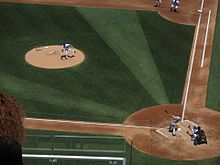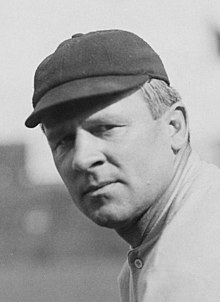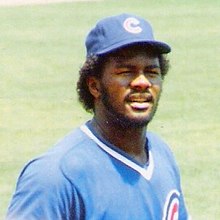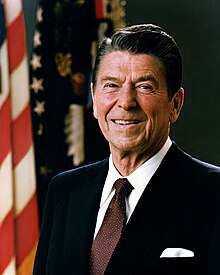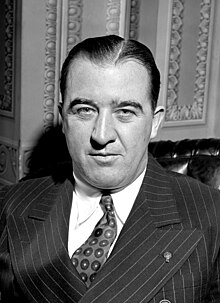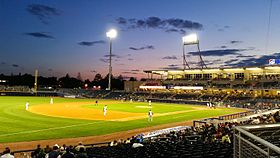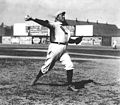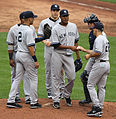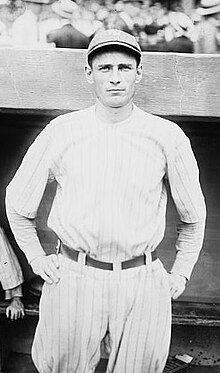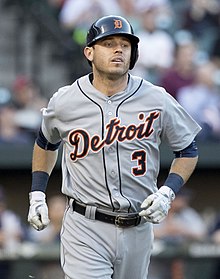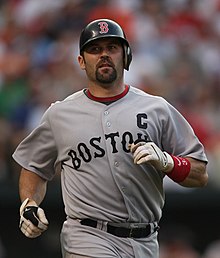Portal:Baseball
Portal maintenance status: (June 2018)
|
| Main page | Content, Categories & Topics | WikiProjects & Things you can do |
The Baseball Portal
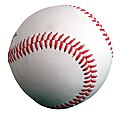
Baseball is a bat-and-ball sport played between two teams of nine players each, taking turns batting and fielding. The game occurs over the course of several plays, with each play generally beginning when a player on the fielding team, called the pitcher, throws a ball that a player on the batting team, called the batter, tries to hit with a bat. The objective of the offensive team (batting team) is to hit the ball into the field of play, away from the other team's players, allowing its players to run the bases, having them advance counter-clockwise around four bases to score what are called "runs". The objective of the defensive team (referred to as the fielding team) is to prevent batters from becoming runners, and to prevent runners advancing around the bases. A run is scored when a runner legally advances around the bases in order and touches home plate (the place where the player started as a batter).
The opposing teams switch back and forth between batting and fielding; the batting team's turn to bat is over once the fielding team records three outs. One turn batting for each team constitutes an inning. A game is usually composed of nine innings, and the team with the greater number of runs at the end of the game wins. Most games end after the ninth inning, but if scores are tied at that point, extra innings are usually played. Baseball has no game clock, though some competitions feature pace-of-play regulations such as the pitch clock to shorten game time.
Baseball evolved from older bat-and-ball games already being played in England by the mid-18th century. This game was brought by immigrants to North America, where the modern version developed. Baseball's American origins, as well as its reputation as a source of escapism during troubled points in American history such as the American Civil War and the Great Depression, have led the sport to receive the moniker of "America's Pastime"; since the late 19th century, it has been unofficially recognized as the national sport of the United States, though in modern times is considered less popular than other sports, such as American football. In addition to North America, baseball spread throughout the rest of the Americas and the Asia–Pacific in the 19th and 20th centuries, and is now considered the most popular sport in parts of Central and South America, the Caribbean, and East Asia, particularly in Japan, South Korea, and Taiwan. (Full article...)
 Featured articles - load new batch
Featured articles - load new batch
-
Image 1
Arthur Joseph Houtteman (August 7, 1927 – May 6, 2003) was an American right-handed pitcher in Major League Baseball who played for 12 seasons in the American League with the Detroit Tigers, Cleveland Indians and Baltimore Orioles. In 325 career games, Houtteman pitched 1,555 innings and posted a win–loss record of 87–91, with 78 complete games, 14 shutouts, and a 4.14 earned run average (ERA).
Known on the sandlot for his pitching motion, Houtteman was signed by scout Wish Egan in 1945 at 17 years of age. He was recruited by major league teams, and joined a Tigers pitching staff that had lost players to injuries and World War II. After moving between the major and minor leagues over the next few years, he was nearly killed in an automobile accident just before the 1949 season. Houtteman rebounded from his injuries and went on to win 15 games that season and made his only All-Star appearance in the following year. (Full article...) -
Image 2
John Joseph McGraw (April 7, 1873 – February 25, 1934) was an American Major League Baseball (MLB) player and manager who was for almost thirty years manager of the New York Giants. He was also the third baseman of the pennant-winning 1890s Baltimore Orioles teams, noted for their innovative, aggressive play.
McGraw was born into poverty in Truxton, New York. He found an escape from his hometown and a bad family situation through baseball, beginning a quick rise through the minor leagues that led him to the Orioles at the age of 18. Under the tutelage of manager Ned Hanlon, the Orioles of the 1890s won three National League (NL) pennants; McGraw was one of the stalwarts of the team alongside Wee Willie Keeler, Hughie Jennings, and Wilbert Robinson. The Orioles perfected the hit and run play and popularized the Baltimore chop; they also sought to win by intimidating the opposing team and the umpire. (Full article...) -
Image 3
Riders Field, formerly known as Dr Pepper/Seven Up Ballpark and Dr Pepper Ballpark, is a baseball park in Frisco, Texas, United States. The home of the Double-A Frisco RoughRiders of the Texas League, it opened on April 3, 2003, and can seat up to 10,216 people. Though primarily a venue for Minor League Baseball games, the facility also hosts high school and college baseball tournaments, and other public and private events throughout the year. It has been the site of three Texas League All-Star Games.
Since its opening, Riders Field has won awards and garnered praise for its unique design, feel, and numerous amenities. In his design, park architect David M. Schwarz desired the creation of a village-like "park within a (ball)park". The stadium received the 2003 Texas Construction Award for Best Architectural Design. (Full article...) -
Image 4

Cobb in 1913
During the 1912 baseball season, center fielder Ty Cobb of the Detroit Tigers was suspended for ten days after entering the spectator stands at New York's Hilltop Park during a game and physically assaulting Claude Lucker, a heckler. At the time, Cobb was among the biggest stars in the major leagues. American League president Ban Johnson suspended Cobb and fined him $50 ($1,600 in 2023).
Cobb had been Lucker's verbal target throughout the four-game series between the Tigers and New York Yankees. Facing a continued stream of insults and questioning about his racial ancestry, Cobb lost his temper in the fourth inning of the fourth game, on May 15, 1912. He raced into the stands, punching and kicking Lucker; Lucker had lost eight fingers in an industrial accident and could not defend himself. Cobb was ejected from the game. Johnson witnessed these events and suspended Cobb indefinitely. Since there were few protections for ballplayers at the time from insults and objects hurled by fans, many took Cobb's side, including his teammates. After defeating the Philadelphia Athletics on May 17, the Detroit players telegraphed Johnson that they would not play again until Cobb was reinstated; Johnson refused to do so. (Full article...) -
Image 5

Ian Michael Chappell (born 26 September 1943) is a former cricketer who played for South Australia and Australia. Known as "Chappelli", he is considered as one of the greatest captains the game has seen. He captained Australia between 1971 and 1975 before taking a central role in the breakaway World Series Cricket organisation. Born into a cricketing family—his grandfather and brother also captained Australia—Chappell made a hesitant start to international cricket playing as a right-hand middle-order batsman and spin bowler. He found his niche when promoted to bat at number three. Chappell's blunt verbal manner led to a series of confrontations with opposition players and cricket administrators; the issue of sledging first arose during his tenure as captain, and he was a driving force behind the professionalisation of Australian cricket in the 1970s. He was the captain of the Australian squad which finished as runners-up at the 1975 Cricket World Cup.
John Arlott called him "a cricketer of effect rather than the graces". An animated presence at the batting crease, he constantly adjusted his equipment and clothing, and restlessly tapped his bat on the ground as the bowler ran in. Basing his game on a sound defence learned during many hours of childhood lessons, Chappell employed the drive and square cut to full effect. He had an idiosyncratic method of playing back and across to a ball of full length and driving wide of mid-on, but his trademark shot was the hook, saying "three bouncers an over should be worth 12 runs to me". A specialist slip fielder, he was the fourth player to take one hundred Test catches. (Full article...) -
Image 6
Marcus Elmore Baldwin (October 29, 1863 – November 10, 1929), nicknamed "Fido" and "Baldy", was an American professional baseball pitcher who played seven seasons in Major League Baseball (MLB). In 346 career games, he pitched to a 154–165 win–loss record with 295 complete games. Baldwin set the single-season MLB wild pitches record with 83 that still stands today.
Born in Pittsburgh, Pennsylvania, Baldwin made his professional debut for a Cumberland, Maryland, team in 1883. Though signed by Chicago White Stockings president Albert Spalding to pitch against the St. Louis Browns in the 1886 World Series, Baldwin did not play after the Browns objected. He made his MLB debut for the White Stockings in 1887, when a writer for the Oshkosh Daily Northwestern called him the "swiftest pitcher in the National League" (NL). Released by Chicago player–manager Cap Anson, he signed with the Columbus Solons of the American Association (AA) in 1889, where he led the league in innings pitched (513+2⁄3), losses (34), strikeouts (368), and walks (274). (Full article...) -
Image 7
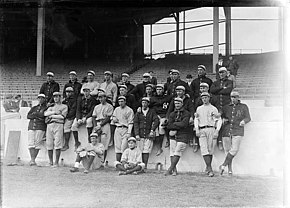
The 1913 squad, the first that went by the name "Yankees"
The history of the New York Yankees Major League Baseball (MLB) team spans more than a century. Frank J. Farrell and William Stephen Devery bought the rights to an American League (AL) club in New York City after the 1902 season. The team, which became known as the Yankees in 1913, rarely contended for the AL championship before the acquisition of outfielder Babe Ruth after the 1919 season. With Ruth in the lineup, the Yankees won their first AL title in 1921, followed by their first World Series championship in 1923. Ruth and first baseman Lou Gehrig were part of the team's Murderers' Row lineup, which led the Yankees to a then-AL record 110 wins and a Series championship in 1927 under Miller Huggins. They repeated as World Series winners in 1928, and their next title came under manager Joe McCarthy in 1932.
The Yankees won the World Series every year from 1936 to 1939 with a team that featured Gehrig and outfielder Joe DiMaggio, who recorded a record hitting streak during New York's 1941 championship season. New York set a major league record by winning five consecutive championships from 1949 to 1953, and appeared in the World Series nine times from 1955 to 1964. Mickey Mantle, Yogi Berra, and Whitey Ford were among the players fielded by the Yankees during the era. After the 1964 season, a lack of effective replacements for aging players caused the franchise to decline on the field, and the team became a money-loser for owners CBS while playing in an aging stadium. (Full article...) -
Image 8William Derrick Bates (born December 7, 1963) is an American former professional baseball second baseman and pinch runner who played in Major League Baseball (MLB) for the Milwaukee Brewers and the Cincinnati Reds. In 29 career games, Bates had a batting average of .125 with six hits, two runs batted in (RBI), 11 runs, and eight stolen bases. Though his defensive position was at second base, the Reds primarily used Bates as a pinch runner. After he scored the winning run in Game 2 of the 1990 World Series, Bates never played in MLB again.
Born in Houston, Bates attended the University of Texas and, in his freshman season, won the 1983 College World Series as a part of the Texas Longhorns baseball team. For the next two seasons, Bates was named to the College Baseball All-America Team, a team composed of the best collegiate baseball athletes in America. Drafted by Milwaukee in the fourth round of the 1985 MLB draft, he rose through the Brewers' farm system helping several of his minor league teams win their respective league titles. He made his MLB debut in 1989, after Milwaukee's starting second baseman Jim Gantner was injured. A trade in 1990 sent Bates to Cincinnati, where the Reds used him primarily as a pinch runner at the end of the regular season and into the postseason. Facing the Oakland Athletics in the World Series, Bates reached base on a pinch hit single against Dennis Eckersley and later scored the winning run in Game 2 as the Reds swept the Athletics four games to none. Following the World Series championship, the Reds re-signed Bates on a one-year contract, and he played for their Triple-A team. He spent the next year with the Chicago Cubs Triple-A affiliate, and last played exhibition baseball in 1995. After retiring, he worked as an equipment supplier in the oil and gas industry in Houston. (Full article...) -
Image 9
Stanley Frank Musial (/ˈmjuːziəl, -ʒəl/; born Stanislaw Franciszek Musial; November 21, 1920 – January 19, 2013), nicknamed "Stan the Man", was an American baseball outfielder and first baseman. Widely considered to be one of the greatest and most consistent hitters in baseball history, Musial spent 22 seasons in Major League Baseball (MLB), playing for the St. Louis Cardinals, from 1941 to 1944 and from 1946 to 1963. He was inducted into the Baseball Hall of Fame in 1969 in his first year of eligibility.
Musial was born in Donora, Pennsylvania, where he frequently played baseball informally or in organized settings, and eventually played on the baseball team at Donora High School. Signed to a professional contract by the St. Louis Cardinals as a pitcher in 1938, Musial was converted into an outfielder and made his major league debut in 1941. Noted for his unique batting stance, he quickly established himself as a consistent and productive hitter. In his first full season, 1942, the Cardinals won the World Series. The following year, he led the NL in six different offensive categories and earned his first MVP award. He was also named to the NL All-Star squad for the first time; he appeared in every All-Star game in every subsequent season he played. Musial won his second World Series championship in 1944, then missed the 1945 season while serving in the Navy. After completing his military service, Musial returned to baseball in 1946 and resumed his consistent hitting. That year he earned his second MVP award and third World Series title. His third MVP award came in 1948, when he finished one home run short of winning baseball's Triple Crown. After struggling offensively in 1959, Musial used a personal trainer to help maintain his productivity until he decided to retire in 1963. (Full article...) -
Image 10
Lee Arthur Smith (born December 4, 1957) is an American former professional baseball pitcher who played 18 years in Major League Baseball (MLB) for eight teams. Serving mostly as a relief pitcher during his career, he was a dominant closer, was the first pitcher to reach 400 saves, and held the major league record for career saves from 1993 until 2006, when Trevor Hoffman passed his total of 478. He was elected to the National Baseball Hall of Fame as part of the class of 2019 by the Today's Game Era Committee.
A native of Jamestown in Bienville Parish in north Louisiana, Smith was scouted by Buck O'Neil and was selected by the Chicago Cubs in the 1975 MLB draft. Smith was an intimidating figure on the pitcher's mound at 6 feet 6 inches (1.98 m) and 265 pounds (120 kg) with a 95-mile-per-hour (150 km/h) fastball. In 1991, he set a National League (NL) record with 47 saves for the St. Louis Cardinals, and was runner-up for the league's Cy Young Award; it was the second of three times Smith led the NL in saves, and he later led the American League (AL) in saves once. When he retired, he held the major league record for career games finished (802) and was third in games pitched (1,022). He holds the Cubs' team record for career saves (180), and held the same record for the Cardinals (160) until 2006. (Full article...) -
Image 11
Ronald Wilson Reagan (February 6, 1911 – June 5, 2004) was an American politician and actor who served as the 40th president of the United States from 1981 to 1989. He was a member of the Republican Party and became an important figure in the American conservative movement. His presidency is known as the Reagan era.
Born in Illinois, Reagan graduated from Eureka College in 1932 and was hired the next year as a sports broadcaster in Iowa. In 1937, he moved to California where he became a well-known film actor. During his acting career, Reagan was president of the Screen Actors Guild twice, from 1947 to 1952 and from 1959 to 1960. In the 1950s, he hosted General Electric Theater and worked as a motivational speaker for General Electric. Reagan's "A Time for Choosing" speech during the 1964 presidential election launched his rise as a leading conservative figure. After being elected governor of California in 1966, he raised state taxes, turned the state budget deficit into a surplus and implemented harsh crackdowns on university protests. Following his loss to Gerald Ford in the 1976 Republican Party presidential primaries, Reagan won the Republican Party's nomination and then a landslide victory over President Jimmy Carter in the 1980 presidential election. (Full article...) -
Image 12
James Howard Thome (/ˈtoʊmi/; TOH-mee; born August 27, 1970) is an American former professional baseball first baseman, third baseman and designated hitter, who played in Major League Baseball (MLB) for 22 seasons (1991–2012). A prolific power hitter, Thome hit 612 home runs during his career—the eighth-most all time. He amassed a total of 2,328 hits and 1,699 runs batted in (RBIs). His career batting average was .276. He was a member of five All-Star teams and won a Silver Slugger Award in 1996.
Thome grew up in Peoria, Illinois, as part of a large blue-collar family of athletes, who predominantly played baseball and basketball. After attending Illinois Central College, he was drafted by the Indians in the 1989 draft, and made his big league debut in 1991. Early in his career, Thome played third base, before eventually becoming a first baseman. With the Indians, he was part of a core of players that led the franchise to five consecutive playoff appearances in the 1990s, including World Series appearances in 1995 and 1997. Thome spent over a decade with Cleveland, before leaving via free agency after the 2002 season, to join the Philadelphia Phillies, with whom he spent the following three seasons. Traded to the Chicago White Sox before the 2006 season, he won the American League (AL) Comeback Player of the Year Award that year and joined the 500 home run club during his three-season tenure with the White Sox. By this point in his career, back pain limited Thome to being a designated hitter. After stints with the Los Angeles Dodgers and Minnesota Twins, he made brief returns to Cleveland and Philadelphia, before ending his career with the Baltimore Orioles. Upon retiring, Thome accepted an executive position with the White Sox. (Full article...) -
Image 13
Albert Benjamin "Happy" Chandler Sr. (July 14, 1898 – June 15, 1991) was an American politician from Kentucky. He represented Kentucky in the U.S. Senate and served as its 44th and 49th governor. Aside from his political positions, he also served as the second commissioner of baseball from 1945 to 1951 and was inducted into the Baseball Hall of Fame in 1982. His grandson, Ben Chandler, later served as congressman for Kentucky's Sixth District.
A multi-sport athlete during his college days at Transylvania College, Chandler briefly considered a career in professional baseball before deciding to pursue a law degree. After graduation, he entered politics and was elected as a Democrat to the Kentucky Senate in 1929. Two years later, he was elected lieutenant governor, serving under Governor Ruby Laffoon. Chandler and Laffoon disagreed on the issue of instituting a state sales tax and when Chandler, the presiding officer in the state senate, worked to block the legislation, Laffoon's allies in the General Assembly stripped him of many of his statutory powers. The tax then passed by a narrow margin. Knowing that Laffoon would try to select his own successor at the Democratic nominating convention, Chandler waited until Laffoon left the state—leaving Chandler as acting governor—and called the legislature into session to enact a mandatory primary election bill. The bill passed, and in the ensuing primary, Chandler defeated Laffoon's choice, Thomas Rhea. He then went on to defeat Republican King Swope by the largest margin of victory for a Kentucky gubernatorial race at that time. As governor, Chandler oversaw the repeal of the sales tax, replacing the lost revenue with new excise taxes and the state's first income tax. He also enacted a major reorganization of state government, realizing significant savings for the state. He used these savings to pay off the state debt and improve the state's education and transportation systems. (Full article...) -
Image 14
First Horizon Park, formerly known as First Tennessee Park, is a baseball park in downtown Nashville, Tennessee, United States. The home of the Triple-A Nashville Sounds of the International League, it opened on April 17, 2015, and can seat up to 10,000 people. It replaced the Sounds' former home, Herschel Greer Stadium, where the team played from its founding in 1978 through 2014.
The park was built on the site of the former Sulphur Dell, a minor league ballpark in use from 1885 to 1963. It is located between Third and Fifth Avenues on the east and west (home plate, the pitcher's mound, and second base are directly in line with Fourth Avenue to the stadium's north and south) and between Junior Gilliam Way and Harrison Street on the north and south. The Nashville skyline can be seen from the stadium to the south. (Full article...) -
Image 15
George Herman "Babe" Ruth (February 6, 1895 – August 16, 1948) was an American professional baseball player whose career in Major League Baseball (MLB) spanned 22 seasons, from 1914 through 1935. Nicknamed "the Bambino" and "the Sultan of Swat", he began his MLB career as a star left-handed pitcher for the Boston Red Sox, but achieved his greatest fame as a slugging outfielder for the New York Yankees. Ruth is regarded as one of the greatest sports heroes in American culture and is considered by many to be the greatest baseball player of all time. In 1936, Ruth was elected to the Baseball Hall of Fame as one of its "first five" inaugural members.
At age seven, Ruth was sent to St. Mary's Industrial School for Boys, a reformatory where he was mentored by Brother Matthias Boutlier of the Xaverian Brothers, the school's disciplinarian and a capable baseball player. In 1914, Ruth was signed to play Minor League baseball for the Baltimore Orioles but was soon sold to the Red Sox. By 1916, he had built a reputation as an outstanding pitcher who sometimes hit long home runs, a feat unusual for any player in the dead-ball era. Although Ruth twice won 23 games in a season as a pitcher and was a member of three World Series championship teams with the Red Sox, he wanted to play every day and was allowed to convert to an outfielder. With regular playing time, he broke the MLB single-season home run record in 1919 with 29. (Full article...)
General images - load new batch
-
Image 1A pitcher handing off the ball after being taken out of the game during a mound meeting. (from Baseball)
-
Image 2Jackie Robinson in 1945, with the era's Kansas City Royals, a barnstorming squad associated with the Negro American League's Kansas City Monarchs (from History of baseball)
-
Image 3Diagram of a baseball field Diamond may refer to the square area defined by the four bases or to the entire playing field. The dimensions given are for professional and professional-style games. Children often play on smaller fields. (from Baseball)
-
Image 4An Afghan girl playing baseball in August 2002 (from Baseball)
-
Image 5Baserunners generally stand a short distance away from their base between pitches, preparing themselves to either go back or steal the next base. (from Baseball rules)
-
Image 6Rickey Henderson—the major leagues' all-time leader in runs and stolen bases—stealing third base in a 1988 game (from Baseball)
-
Image 7Jackie Robinson in 1945, with the era's Kansas City Royals, a barnstorming squad associated with the Negro American League's Kansas City Monarchs (from Baseball)
-
Image 8The standard fielding positions (from Baseball rules)
-
Image 10Sadaharu Oh managing the Japan national team in the 2006 World Baseball Classic. Playing for the Central League's Yomiuri Giants (1959–80), Oh set the professional world record for home runs with 868. (from History of baseball)
-
Image 13Two players on the baseball team of Tokyo, Japan's Waseda University in 1921 (from Baseball)
-
Image 14A New York Yankees batter (Andruw Jones) and a Boston Red Sox catcher at Fenway Park (from Baseball)
-
Image 15Sadaharu Oh managing the Japan national team in the 2006 World Baseball Classic. Playing for the Central League's Yomiuri Giants (1959–80), Oh set the professional world record for home runs. (from Baseball)
-
Image 16Alexander Cartwright, father of modern baseball (from History of baseball)
-
Image 17Pesäpallo, a Finnish variation of baseball, was invented by Lauri "Tahko" Pihkala in the 1920s, and after that, it has changed with the times and grown in popularity. Picture of Pesäpallo match in 1958 in Jyväskylä, Finland. (from Baseball)
-
Image 19The typical motion of a right-handed pitcher (from Baseball rules)
-
Image 20A runner sliding into home plate and scoring. (from Baseball)
-
Image 22By the 1860s Civil War, baseball (bottom) had overtaken its fellow bat-and-ball sport cricket (top) in popularity within the United States. (from History of baseball)
-
Image 232013 World Baseball Classic championship match between the Dominican Republic and Puerto Rico, March 20, 2013 (from Baseball)
-
Image 25Japanese-Americans spectating a World War II-era game while in an internment camp. America's ties to immigrants and to Japan have been deeply shaped by a shared baseball heritage. (from History of baseball)
-
Image 26The strike zone determines the result of most pitches, and varies in vertical length for each batter. (from Baseball)
-
Image 27Fenway Park, home of the Boston Red Sox. The Green Monster is visible beyond the playing field on the left. (from Baseball)
-
Image 28Baseball games sometimes end in a walk-off home run, with the batting team usually gathering at home plate to celebrate the scoring of the winning run(s). (from Baseball rules)
-
Image 29Cover of Official Base Ball Rules, 1921 edition, used by the American League and National League (from Baseball rules)
-
Image 30A well-worn baseball (from Baseball)
-
Image 31Diagram indicating the standard layout of positions (from Baseball)
-
Image 33A batter follows through after swinging at a pitched ball. (from Baseball rules)
-
Image 341906 World Series, infielders playing "in" for the expected bunt and the possible play at the plate with the bases loaded (from Baseball rules)
-
Image 35The American Tobacco Company's line of baseball cards featured shortstop Honus Wagner of the Pittsburgh Pirates from 1909 to 1911. In 2007, the card shown here sold for $2.8 million. (from Baseball)
-
Image 36Cy Young—the holder of many major league career marks, including wins and innings pitched, as well as losses—in 1908. MLB's annual awards for the best pitcher in each league are named for Young. (from Baseball)
-
Image 38Pitchers are generally substituted during mound visits (team gatherings at the pitcher's mound). (from Baseball rules)
-
Image 39The NL champion New York Giants baseball team, 1913. Fred Merkle, sixth in line, had committed a baserunning gaffe in a crucial 1908 game that became famous as Merkle's Boner. (from History of baseball)
-
Image 40A game from the Cantigas de Santa Maria, c. 1280, involving tossing a ball, hitting it with a stick and competing with others to catch it (from History of baseball)
-
Image 42Pick-off attempt on runner (in red) at first base (from Baseball rules)
-
Image 43The strike zone, which determines the outcome of most pitches, varies in vertical length depending on the batter's typical height while swinging. (from Baseball rules)
-
Image 44In May 2010, the Philadelphia Phillies' Roy Halladay pitched the 20th major league perfect game. That October, he pitched only the second no-hitter in MLB postseason history. (from History of baseball)
-
Image 45A first baseman receives a pickoff throw, as the runner dives back to first base. (from Baseball)
 Good articles - load new batch
Good articles - load new batch
-
Image 1
Paul Glee Waner (April 16, 1903 – August 29, 1965), nicknamed "Big Poison", was an American professional baseball right fielder who played in Major League Baseball (MLB) for four teams between 1926 and 1945, most notably playing his first 15 seasons with the Pittsburgh Pirates. The greatest Pirate outfielder up to his retirement, he won the 1927 NL Most Valuable Player Award in his second season, collecting a team-record 237 hits that year. Waner set the team record for doubles in a season three times, including 1932 when he set the NL record for doubles in a season with 62. In the only postseason appearance of his career, he hit .333 in the Pirates' 1927 World Series loss against the New York Yankees. Waner won three National League (NL) batting titles, led the NL in hits twice, and collected over 200 hits eight times including four consecutive seasons from 1927 to 1930.
On June 19, 1942, Waner became the seventh member of the 3,000 hit club, with a single off Rip Sewell. He led the NL in putouts four times and holds the career record for most putouts by a right fielder. Waner's 191 triples are 10th all-time, and his 605 doubles are 14th all-time. A career .333 hitter, he was elected to the National Baseball Hall of Fame in 1952. When Waner's younger brother Lloyd was elected to the Hall of Fame, they became the second pair of brothers in the National Baseball Hall of Fame, after Harry and George Wright. Paul and Lloyd also hold the record for the most hits recorded by brothers (5,611). On July 21, 2007, Waner's No. 11 was retired by the Pittsburgh Pirates. (Full article...) -
Image 2
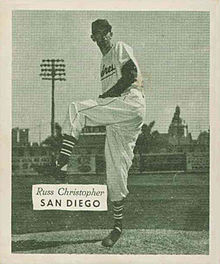
Russell Ormand Christopher (September 12, 1917 – December 5, 1954) was a professional baseball pitcher who played in Major League Baseball for seven seasons with the Philadelphia Athletics (1942-1947) and Cleveland Indians (1948). In 241 career games, Christopher pitched 999+2⁄3 innings and posted a win–loss record of 54–64, with 46 complete games, three shutouts, and a 3.37 earned run average (ERA).
A 6'3, 180 lb. player from Richmond, California, he played minor league baseball in the New York Yankees organization before being acquired by the Athletics in the rule 5 draft. Christopher joined the Athletics' major league roster in 1942 and played six seasons for them, and made his only All-Star appearance in 1945. He was traded to the Indians before the 1948 season, and played one year of baseball with them. After the season ended, he retired due to health concerns and worked at an aircraft plant until his death in 1954. (Full article...) -
Image 3
Walter Clement Pipp Sr. (February 17, 1893 – January 11, 1965) was an American professional baseball player. A first baseman, Pipp played in Major League Baseball (MLB) for the Detroit Tigers, New York Yankees, and Cincinnati Reds between 1913 and 1928.
After appearing in 12 games for the Tigers in 1913 and playing in the minor leagues in 1914, he was purchased by the Yankees before the 1915 season. They made him their starting first baseman. He and Home Run Baker led an improved Yankee lineup that led the league in home runs. He led the American League in home runs in 1916 and 1917. With Babe Ruth, Bob Meusel, Joe Dugan, and Waite Hoyt, the Yankees won three consecutive American League pennants from 1921 through 1923, and won the 1923 World Series. In 1925, he lost his starting role to Lou Gehrig, after which he finished his major league career with Cincinnati. (Full article...) -
Image 4
Ian Michael Kinsler (Hebrew: איאן קינסלר; born June 22, 1982) is an American-Israeli former professional baseball second baseman. He played in Major League Baseball (MLB) for 14 seasons for the Texas Rangers, Detroit Tigers, Los Angeles Angels, Boston Red Sox, and San Diego Padres. Kinsler was a four-time All Star, two-time Gold Glove winner, and a member of the 2018 World Series champion Boston Red Sox.
Despite having been drafted in the 17th round of the 2000 MLB draft out of college, Kinsler rose to become a four-time All-Star and a member of the Sporting News 2009 list of the 50 greatest current players in baseball. He was known as a five-tool player, hitting for average and power, and excelling in baserunning, throwing, and fielding. ('Full article...) -
Image 5

Wilmer David "Vinegar Bend" Mizell Sr. (August 13, 1930 – February 21, 1999) was an American baseball player and politician. From 1952 to 1962, he was a left-handed pitcher for the St. Louis Cardinals, Pittsburgh Pirates and New York Mets of Major League Baseball. Six years after retiring, he was elected to the United States House of Representatives from North Carolina's 5th congressional district. He served three terms as a Republican from 1969 to 1975.
Mizell was born in Leakesville, Mississippi, but started playing baseball in Vinegar Bend, Alabama, the town from which he drew his nickname. Signed by the Cardinals in 1949, he debuted with them in 1952, ranking among the Top 10 in the National League (NL) in strikeouts for two years before spending 1954 and 1955 in military service. He returned to the Cardinals in 1956 and was named to two Major League Baseball All-Star Games in 1959, but St. Louis felt like he never attained his full potential. They traded him to Pittsburgh early in the 1960 season, and Mizell led the NL in winning percentage (.636) as the Pirates defeated the New York Yankees in the 1960 World Series. He remained with the Pirates until early in the 1962 season, last pitching in the major leagues with the Mets. (Full article...) -
Image 6
The 1995 American League West tie-breaker game was a one-game extension to Major League Baseball's (MLB) 1995 regular season; the California Angels and Seattle Mariners met to determine the winner of the American League's (AL) West Division. It was played at the Kingdome in Seattle, on October 2, 1995.
The game was necessary after both teams finished the strike-shortened 144-game season with identical records of 78–66 (.542). Scoreless until the fifth inning, Seattle held a slim 1–0 lead at the seventh-inning stretch. The Mariners then broke it open and won 9–1 to secure the franchise's first postseason berth. It was counted as the 145th regular season game for both teams, with all the events in the game added to regular season statistics. (Full article...) -
Image 7Pounders pitching for the Omaha Storm Chasers in 2016
Brooks Casey Pounders (born September 26, 1990) is an American former professional baseball pitcher. He attended Temecula Valley High School in Temecula, California, and chose not to attend college after he was drafted by the Pittsburgh Pirates in 2009. After playing in the minor leagues for the Pirates, he was traded to the Kansas City Royals after the 2011 season. While in the Royals' minor league system, Pounders threw a no-hitter for the Northwest Arkansas Naturals in 2013. He made his major league debut with the Royals in 2016, and he was traded to the Los Angeles Angels after the season ended.
Pounders spent 2017 alternating between the Angels' major league club and the minor leagues, before becoming a free agent at the end of the season. Before the 2018 season, Pounders signed a contract with the Colorado Rockies and played for both the Rockies and their Triple A-level affiliate. Again a free agent after the 2018 season, Pounders signed with the Cleveland Indians, but never played a major league game with the team. On June 15, he was traded to the New York Mets and immediately became part of the Mets' major league team. He played briefly with the team before being sent back down to the minor league Syracuse Mets. Pounders was part of the United States national baseball team in the 2015 and 2019 WBSC Premier12 tournaments. (Full article...) -
Image 8
Edgar Martínez (born January 2, 1963), nicknamed "Gar" and "Papi", is a Puerto Rican former professional baseball player who is currently the senior director of hitting strategy coach for the Seattle Mariners of Major League Baseball (MLB). He played in MLB as a designated hitter and third baseman for Seattle from 1987 to 2004. He served as the Mariners' hitting coach from 2015 to 2018, and currently in 2024. He has also been a hitting advisor with the Mariners from 2019 through 2024.
Martínez grew up in Dorado, Puerto Rico. Not highly regarded as a prospect, he signed with the Mariners as a free agent in 1982, and was given a small signing bonus. He made his major league debut in 1987, but did not establish himself as a full-time player until 1990, at age 27. In the 1995 American League Division Series, he hit "The Double", which won the series and increased public support for Mariners baseball as they attempted to fund a new stadium. He continued to play until 2004, when injuries forced him to retire. (Full article...) -
Image 9
Jarrod Scott Saltalamacchia (/ˌsɒltələˈmɑːkiə/; born May 2, 1985) is an American former professional baseball catcher. Between 2007 and 2018, he played in Major League Baseball (MLB) for the Atlanta Braves, Texas Rangers, Boston Red Sox, Miami Marlins, Arizona Diamondbacks, Detroit Tigers, and Toronto Blue Jays.
Raised in West Palm Beach, Florida, Saltalamacchia attended Royal Palm Beach High School. His performance on the institution's baseball team drew the attention of scouts, and the Braves selected him in the first round of the 2003 MLB Draft. He spent four years in the Braves' farm system, but in 2007, injuries to both of Atlanta's regular catchers forced them to call him up to the major leagues. Saltalamacchia was prevented from becoming a regular catcher for the Braves by the presence of Brian McCann, and so he became the centerpiece of a trading deadline deal with the Rangers in 2007. Shortly after becoming the team's starting catcher in 2009, a bout of thoracic outlet syndrome forced Saltalamacchia to undergo season-ending rib removal surgery, and lingering issues from the surgery caused him to suffer from the "yips" in 2010. (Full article...) -
Image 10
Dennis Lawrence "Dan" McGann (July 15, 1871 – December 13, 1910) was an American professional baseball first baseman and second baseman. He played in Major League Baseball (MLB) from 1896 to 1910, and won the World Series in 1905 with the New York Giants.
After beginning his professional career in minor league baseball in 1895, McGann played in MLB for the Boston Beaneaters (1896), Baltimore Orioles (1898), Brooklyn Superbas (1899), Washington Senators (1899), and St. Louis Cardinals (1900–1901) of the National League (NL) before jumping to the rival American League to play for the Baltimore Orioles in 1902. He returned to the NL, playing for the New York Giants (1902–1907) and Boston Doves (1908). In 1909–10, he played for the Milwaukee Brewers in the American Association. (Full article...) -
Image 11Edward James Zosky (born February 10, 1968) is a former professional baseball shortstop. He played in brief parts of five seasons in Major League Baseball, between 1991 and 2000, for the Toronto Blue Jays, Florida Marlins, Milwaukee Brewers and Houston Astros. He also played in the Baltimore Orioles, San Francisco Giants and Pittsburgh Pirates minor league systems.
Zosky was a collegiate star prior to playing professionally, becoming a member of Fresno State University's athletic Hall of Fame. He developed into a promising shortstop prospect for the Toronto Blue Jays in the early 1990s, being named their starting shortstop of the future multiple times, though injury problems and a lack of offense ended his hopes of stardom. (Full article...) -
Image 12Galarraga pitching for the Detroit Tigers in 2010
In a Major League Baseball game played on June 2, 2010, at Detroit's Comerica Park, Detroit Tigers pitcher Armando Galarraga nearly became the 21st pitcher in Major League Baseball history to throw a perfect game. Facing the Cleveland Indians, Galarraga retired the first 26 batters he faced. His bid for a perfect game was ruined one out short when first-base umpire Jim Joyce incorrectly ruled that Indians batter Jason Donald reached first base safely on a ground ball. Galarraga instead finished with a one-hit shutout in a 3–0 victory. He faced 28 batters and threw 88 pitches (67 strikes and 21 balls), striking out three. The game is sometimes referred to as the "28-out perfect game", the "almost perfect game", the "extra perfect game", the "imperfect game", or simply the "Galarraga game".
Joyce was tearful and apologetic upon meeting with Galarraga after the game after realizing that he had made an incorrect call. Galarraga was forgiving and understanding of the mistake, telling reporters after the game, "Nobody's perfect." Many others throughout Major League Baseball subsequently voiced their support for Joyce. The sportsmanship demonstrated by Galarraga and Joyce earned them widespread praise for their handling of the incident. (Full article...) -
Image 13
"Baseball's Sad Lexicon," also known as "Tinker to Evers to Chance" after its refrain, is a 1910 baseball poem by Franklin Pierce Adams. The eight-line poem is presented as a single, rueful stanza from the point of view of a New York Giants fan watching the Chicago Cubs infield of shortstop Joe Tinker, second baseman Johnny Evers, and first baseman Frank Chance complete a double play. These three players helped the Cubs win four National League championships and two World Series from 1906 to 1910.
"Baseball's Sad Lexicon" became popular across the United States among sportswriters, who wrote their own verses along the same vein. The poem only enhanced the reputations of Tinker, Evers, and Chance over the succeeding decades as the phrase became synonymous with a feat of smooth and ruthless efficiency. It has been credited with their elections to the National Baseball Hall of Fame in 1946. (Full article...) -
Image 14Taveras with the St. Louis Cardinals in 2014
Oscar Francisco Taveras (June 19, 1992 – October 26, 2014) was a Dominican–Canadian professional baseball outfielder who played one season for the St. Louis Cardinals of Major League Baseball (MLB). Known as "El Fenómeno" (Spanish for "The Phenomenon") in the Dominican Republic, the Cardinals signed him at age 16 in 2008 as an international amateur free agent and he made his MLB debut in 2014. Over six minor league seasons, he batted .321 with a .519 slugging percentage. He played all three outfield positions while spending most of the time in center field.
With prodigious batting skills, Taveras was a consensus top-five minor league prospect in 2013 and 2014. He elicited comparisons to former MLB outfielder and fellow Dominican Vladimir Guerrero—with a powerful and smooth, balanced stroke, Taveras successfully hit pitches well outside of the strike zone. Also similar to Guerrero, he possessed a strong and accurate throwing arm. The outfielder was the recipient of a litany of awards and won batting titles in two minor leagues, including hitting .386 for the Midwest League title in 2011. The next year, he won the Texas League batting title and was the Texas League Player of the Year and Cardinals organization Player of the Year. (Full article...) -
Image 15
On June 17, 1880, John Montgomery Ward of the Providence Grays threw a perfect game against the Buffalo Bisons at Messer Street Grounds. It was the second perfect game in Major League Baseball history, which at the time only consisted of the National League (NL). Ward's perfect game occurred just five days after Lee Richmond's perfect game.
Ward was one of the best pitchers in the NL, and posted a 1.74 earned run average in 1880. Due to limited reporting from contemporary sources, little is known about Ward's perfect game outside of the box score. The opposing pitcher was Pud Galvin, who allowed five runs in nine innings. One newspaper noted there were a couple of strong defensive plays that helped preserve Ward's perfect game, such as a difficult catch made by center fielder Paul Hines, and "some wonderful stops" by shortstop John Peters. (Full article...)
Did you know (auto-generated) - load new batch

- ... that Dominic Keegan refused a position on the New York Yankees to "go back and win another championship" for his college baseball team?
- ... that Puerto Rico's Willie Hernández became the highest paid player in Detroit Tigers history after winning Cy Young and Most Valuable Player awards and a World Series?
- ... that the parents of Bob Glenalvin insisted that he play baseball under an assumed name?
- ... that Mike Veeck's baseball promotions include Disco Demolition Night, a game with no fans, and the world's largest pillow fight?
- ... that doctors told Lance McCullers that he should not continue to pitch in 1990, but he returned to Major League Baseball in 1992?
- ... that Brewer Hicklen hosts an annual youth baseball camp in Alabama?
- ... that baseball player Shane Rawley has published a novel?
- ... that baseball player Nick Solak was named after the sports bar where his parents first met?
Quotes
| Money wasn't an issue because I could have made more money playing in Japan. This is like going from a beat-up Volkswagen to a Mercedes.''
— Masato Yoshii, Starting pitcher, on his departing the Tokyo Yakult Swallows of the Japanese Central League for the New York Mets of Major League Baseball
|
 Featured lists - load new batch
Featured lists - load new batch
-
Image 1The San Diego Padres are an American professional baseball team based in San Diego. The Padres compete in Major League Baseball (MLB) as a member club of the National League (NL) West Division. Since the institution of MLB's Rule 4 Draft, the Padres have selected 73 players in the first round. Officially known as the "First-Year Player Draft", the Rule 4 Draft is MLB's primary mechanism for assigning players from high schools, colleges, and other amateur clubs to its franchises. The draft order is determined based on the previous season's standings, with the team possessing the worst record receiving the first pick. In addition, teams which lost free agents in the previous off-season may be awarded compensatory or supplementary picks. The First-Year Player Draft is unrelated to the 1968 expansion draft in which the Padres initially filled their roster.
Of the 73 players picked in the first round by San Diego, 32 have been pitchers, the most of any position; 20 of these were right-handed, while 12 were left-handed. Fourteen outfielders were selected, while ten shortstops, seven catchers, five third basemen, and four first basemen were taken as well. The team has also drafted one player at second base. Eleven of the players came from high schools or universities in the state of California, and Florida and Georgia follow with ten and six players, respectively. (Full article...) -
Image 2

The 1879 Cleveland Blues baseball team
The Cleveland Blues were a professional baseball franchise that operated in the National League (NL), a "major" league, from 1879 until 1884. They were organized by businessmen William Hollinger, and J. Ford Evans in 1878 as the Forest Citys, and played a season as an independent team. The NL expanded from six teams to eight before the 1879 season, and the Forest Citys accepted an invitation to join the league. Evans became their president and stayed in that capacity until C. H. Bulkeley assumed the role in 1882. In their six seasons in the NL, the team never finished higher than third place in the standings. They played their home games in League Park.
For their first season in the NL, the franchise (now named the Blues due to their dark blue uniforms) employed Jim McCormick as the manager as well as the ace of their pitching staff. Cleveland did not fare well, winning just 27 games against 55 losses, with a league-low .223 batting average. The 1880 season was better, however, as the team increased its win total to 47 against 37 losses and a tie, McCormick winning a league-leading 45 of those victories. Over the next two seasons, the team changed the on-field leadership often; employing Mike McGeary and John Clapp as player-managers in 1881, and Fred Dunlap in 1882. The changes did not prove effective as the team was unable to finish higher than fifth place during that span. The team had their best record and highest win total in 1883 under manager Frank Bancroft. On September 13, 1883, Hugh Daily threw the franchise's lone no-hitter. (Full article...) -
Image 3First-round selections Ken Griffey Jr. (top left), Mike Harkey (top right), Jack McDowell (bottom left), and Mike Remlinger (bottom right).
The 1987 Major League Baseball draft is the process by which Major League Baseball (MLB) teams select athletes to play for their organization. High school seniors, college juniors and seniors, and anyone who had never played under a professional contract were considered eligible for the draft. The 1987 MLB Draft took place as a conference call to the Commissioner of Baseball's office in New York from June 2–4. As opposed to the National Football League Draft which appeared on ESPN, no network aired the MLB Draft.
The American League (AL) and the National League (NL) alternated picks throughout the first round; because an NL team drafted first in the 1986 MLB Draft, an AL team had the first selection in 1987. Having finished 67–95 in 1986, the Seattle Mariners had the worst record in the AL and thus obtained the first overall selection. The second selection went to the Pittsburgh Pirates, who had the worst record in the NL. (Full article...) -
Image 4The 1971 Cy Young Award won by Ferguson Jenkins, on display in the Canadian Baseball Hall of Fame
The Cy Young Award is given annually to the best pitchers in Major League Baseball (MLB), one each for the American League (AL) and National League (NL). The award was introduced in 1956 by Baseball Commissioner Ford C. Frick in honor of Hall of Fame pitcher Cy Young, who died in 1955. The award was originally given to the single best pitcher in the major leagues, but in 1967, after the retirement of Frick, the award was given to one pitcher in each league.
Each league's award is voted on by members of the Baseball Writers' Association of America (BBWAA). Local BBWAA chapter chairmen in each MLB city recommend two writers to vote for each award. Final approval comes from the BBWAA national secretrary-treasurer. Writers vote for either the American League or National League awards, depending on the league in which their local team plays. A total of 30 writers vote for each league's awards. Writers cast their votes prior to the start of postseason play. (Full article...) -
Image 5In its 108-year history, the Minnesota Twins baseball franchise of Major League Baseball's American League has employed 31 managers. The duties of the manager include team strategy and leadership on and off the field. Eight of these team managers have been "player-managers", all during the Washington Senators era; specifically, they managed the team while still playing for it.
The Minnesota franchise began its life as the Washington Senators in Washington, D. C., where they played from their inception in 1901 to 1960. In the early twentieth century, the Senators were managed consecutively by three future members of the National Baseball Hall of Fame, bookended by Bucky Harris, who managed the team from 1924 to 1928 and again from 1935 to 1942. Walter Johnson managed the team for four seasons from 1929 to 1932, and he was followed by Joe Cronin, who led for the next two seasons (1933–1934). In 1960, the American League awarded an expansion franchise to Minneapolis, Minnesota; however, owner Calvin Griffith moved his team to Minnesota, and Washington was awarded the expansion team instead. Thus, the Minnesota Twins began play at Metropolitan Stadium in Bloomington, Minnesota the following year, during the tenure of manager Cookie Lavagetto, and played at the Hubert H. Humphrey Metrodome in downtown Minneapolis from 1982 to 2009. Under manager Ron Gardenhire, the team moved to Target Field beginning in the 2010 season. (Full article...) -
Image 6
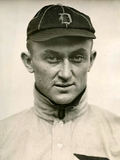
Ty Cobb won more batting titles than any other player, though the precise number is unclear because of the race in the 1910 American League.
In baseball, batting average (AVG) is a measure of a batter's success rate in achieving a hit during an at bat. In Major League Baseball (MLB), it is calculated by dividing a player's hits by his at bats (AB). In MLB, a player in each league[L] wins the "batting title" each season for having the highest batting average that year. The American League (AL) winner is known as the "Rod Carew American League Batting Champion", while the National League (NL) leader is designated the "Tony Gwynn National League Batting Champion". Since 1957, a player must have 3.1 plate appearances (PA) per scheduled game in that league (for a total of 502 over the current 162-game season) to qualify for the batting title. However, if a player's lead in AVG is sufficiently large that enough hitless at bats can be added to reach this requirement and the player still would have the highest batting average, he wins the title. Tony Gwynn, for example, had 159 hits in 451 ABs in 1996 (.353 average) but only 498 PAs. Gwynn's batting average would have dropped to .349 (159 hits in 455 ABs) with four hitless ABs added to reach the 502 PA requirement, but this would still have been higher than the next-highest eligible player (Ellis Burks with a .344 average), so he was awarded the 1996 NL batting title.
MLB officially incorporated Negro League statistics into its record book on Wednesday, May 29, 2024. On December 16, 2020, MLB announced that the records of Negro League Baseball from 1920-1948 would be designated as major league status. From 2020-2024, MLB and the Elias Sports Bureau, completed a comprehensive review of the Seamheads database in coordination with Retrosheet. The MLB database combines statistics from the Negro Leagues with existing data from the AL, NL, and other Major Leagues throughout history. As such, seven different leagues that existed during that time period are now recognized as being on the same level as MLB, which include: the Negro National League (I) (1920-1931); the Eastern Colored League (1923-1928); the American Negro League (1929); the East-West League (1932); the Negro Southern League (1932); the Negro National League (II) (1933-1948); and the Negro American League (1937-1948).
The first batting average champion in the NL was Ross Barnes; in the league's inaugural 1876 season, Barnes batted .429 for the Chicago White Stockings. The AL was established in 1901, and Hall of Fame second baseman Nap Lajoie led that league with a .426 average for the Philadelphia Athletics. Josh Gibson of the Homestead Grays and Pittsburgh Crawfords, is recognized as the MLB all-time batting champion, with a career batting average of .372. Gibson amassed career totals of 838 hits in 2,255 at-bats and 628 games, and is also the MLB all-time career leader in Slugging (SLG) percentage and On-Base Plus Slugging (OPS) percentage. (Full article...) -
Image 7

In baseball, a strikeout occurs when a pitcher throws three strikes to a batter during his time at bat. Twenty different pitchers have struck out at least 18 batters in a single nine-inning Major League Baseball (MLB) game, the most recent being Max Scherzer of the Washington Nationals on May 11, 2016. Four players have accomplished the feat more than once in their career; no player has ever struck out more than 20 batters in a nine-inning game. Charlie Sweeney was the first player to strike out 18 batters in a single game, doing so for the Providence Grays against the Boston Beaneaters on June 7, 1884. In spite of this, Bob Feller is viewed as the first pitcher to accomplish the feat, since his then-record 18 strikeouts was the first to occur during the 20th century and the live-ball era.
Out of the twenty pitchers who have accomplished the feat, fifteen were right-handed and five pitched left-handed. Five of these players have played for only one major league team. Six pitchers—Steve Carlton, Roger Clemens, Randy Johnson, Nolan Ryan, Tom Seaver, and Max Scherzer—are also members of the 3,000 strikeout club. Sweeney has the fewest career strikeouts in the group with 505, while Nolan Ryan, with 5,714, struck out more batters than any other pitcher in major league history. Bill Gullickson and Kerry Wood are the only rookies to have achieved the feat. Tom Seaver concluded his milestone game by striking out the final ten batters he faced, setting a new major league record for most consecutive strikeouts. (Full article...) -
Image 8

Mike Scioscia (1976) won championships with the Dodgers in 1981 and 1988.
The Los Angeles Dodgers are a Major League Baseball (MLB) franchise based in Los Angeles, California. They play in the National League West division. Since the institution of MLB's Rule 4 Draft, the Dodgers have selected 67 players in the first round. Officially known as the "First-Year Player Draft", the Rule 4 Draft is MLB's primary mechanism for assigning players from high schools, colleges, and other amateur clubs to its franchises. The draft order is determined based on the previous season's standings, with the team possessing the worst record receiving the first pick. In addition, teams which lost free agents in the previous off-season may be awarded compensatory or supplementary picks.
Of the 67 players picked in the first round by Los Angeles, 37 have been pitchers, the most of any position; 24 of these were right-handed, while 12 were left-handed. Nine players at shortstop and nine in the outfield were selected, while five catchers, three first basemen, and three third basemen were taken as well. The team also selected two players at second base. Seven of the players came from high schools or universities in the state of Texas, while California follows with six players. (Full article...) -
Image 9
An All-American team is an honorary sports team composed of the best amateur players of a specific season for each position—who in turn are given the honorific "All-America" and typically referred to as "All-American athletes", or simply "All-Americans". Although the honorees generally do not compete as a unit, the term is used in U.S. team sports to refer to players who are selected by members of the national media. Walter Camp selected the first All-America team in the early days of American football in 1889. In 1950, the American Baseball Coaches Association (ABCA) selected its first All-American baseball team. It has since chosen All-American teams and a player of the year for each division (National Collegiate Athletic Association (NCAA) Division I, Division II, Division III, National Association of Intercollegiate Athletics, junior college and high school). Collegiate Baseball selects All-American, Freshman All-American and High School All-American teams. Baseball America magazine selects pre-season and post-season All-American teams and College Player of the Year honorees.
Various organizations selected All-American lists of the best players for the 1993 NCAA Division I college baseball season. The ABCA, the magazine Baseball America, and Collegiate Baseball were the NCAA-sanctioned selectors. This list only includes players selected to the post-season All-American first team for each selector. However, many All-American selections choose second, third, etc. teams from the remaining eligible candidates. (Full article...) -
Image 10

Hard Rock Stadium, the Marlins former home ballpark from 1993-2011
The Miami Marlins are a Major League Baseball (MLB) franchise based in Miami, Florida. They play in the National League East division. The first game of the new baseball season for a team is played on Opening Day, and being named the Opening Day starter is an honor, which is often given to the player who is expected to lead the pitching staff that season, though there are various strategic reasons why a team's best pitcher might not start on Opening Day. The Marlins have used 17 different Opening Day starting pitchers in their 27 seasons. Since the Marlins' first season in 1993, the 17 starters have a combined Opening Day record of 12 wins and 14 losses with two no-decisions. Notably, no Marlins Opening Day starter received a no-decision until the team's 24th season in 2016. No-decisions are only awarded to the starting pitcher if the game is won or lost after the starting pitcher has left the game.
Nine Marlins pitchers have started on two or more Opening Days. Those nine are Charlie Hough, Kevin Brown, Alex Fernandez, Ryan Dempster, Josh Beckett, Dontrelle Willis, Josh Johnson, Ricky Nolasco, and José Ureña. Beckett and Johnson hold the record for most Opening Day starts as a Marlin, with three appearances each, from 2003 to 2005 for Beckett and 2010 to 2012 for Johnson. When playing at their original home field, the venue now known as Hard Rock Stadium, the Marlins had a record of nine wins and five losses (9–5). At their current home of Marlins Park, Opening Day pitchers have a record of 1–5 with one no-decision. In the franchise's history, the Marlins have only played Opening Day games at another team's home stadium eight times. As the away team, Marlins' starting pitchers have an Opening Day record of 1–6 with one no-decision. (Full article...) -
Image 11

Justin Upton, the first overall selection in 2005, was named to the 2009 All-Star Team.
The Arizona Diamondbacks are a Major League Baseball franchise based in Phoenix, Arizona. The Diamondbacks compete in the National League West division. Officially known as the "First-Year Player Draft", the Rule 4 Draft is Major League Baseball's primary mechanism for assigning amateur baseball players from high schools, colleges, and other amateur baseball clubs to its teams. The draft order is determined based on the previous season's standings, with the team possessing the worst record receiving the first pick. In addition, teams which lost free agents in the previous off-season may be awarded compensatory or supplementary picks. Since the franchise first participated in the draft in 1996, the Diamondbacks have selected 28 players in the first round. The First-Year Player Draft is unrelated to the 1997 expansion draft in which the Diamondbacks filled their roster.
Of the 28 players picked in the first round by the Diamondbacks, 15 have been pitchers, the most of any position; 11 of these have been right-handed, while 4 have been left-handed. Five players taken in the first round have been shortstops; additionally, two players have been selected at each of first base, third base, catcher, and the outfield. No second baseman has been selected in the first round by the Diamondbacks. The Diamondbacks have drafted 16 players out of college, and 10 out of high school. Arizona has drafted seven players out of high schools or colleges in the state of California, with two being taken from each of Florida, Georgia, and their home state of Arizona. (Full article...) -
Image 12
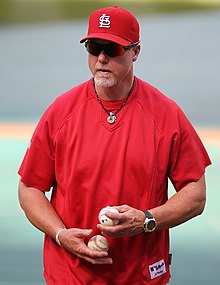
In Major League Baseball (MLB), the 50 home run club is the group of batters who have hit 50 or more home runs in a single season. Babe Ruth was the first to achieve this, doing so in 1920. By reaching the milestone, he also became the first player to hit 30 and then 40 home runs in a single season, breaking his own record of 29 from the 1919 season. Ruth subsequently became the first player to reach the 50 home run club on four occasions, repeating the achievement in 1921, 1927, and 1928. He remained the only player to accomplish this until Mark McGwire and Sammy Sosa matched his feat in 1999 and 2001, respectively. In doing so, they became the only players to have achieved 50 home runs in four consecutive seasons. Barry Bonds hit the most home runs to join the club, collecting 73 in 2001. The most recent player to hit 50 home runs in three seasons is Aaron Judge, who did so in 2024.
In total, 32 players have reached the 50 home run club in MLB history and ten have done so more than once. Of these, seventeen were right-handed batters, fourteen were left-handed, and one was a switch hitter, meaning he could bat from either side of the plate. Four of these players (including two active members of the 50 home run club) have played for only one major league team. The New York Yankees are the only franchise to have five players reach the milestone while on their roster: Ruth, Mickey Mantle, Roger Maris, Alex Rodriguez, and Aaron Judge. Ten players are also members of the 500 home run club and two of them (Willie Mays and Rodriguez) are also members of the 3,000 hit club. Ten players won the Most Valuable Player (MVP) Award in the same year as their 50 home run season. Mantle is the only player to have earned the Major League Triple Crown alongside achieving 50 home runs, leading both leagues in batting average, home runs and runs batted in (RBI). Mantle and Maris—collectively known as the M&M Boys—are the only teammates to reach the 50 home run club in the same season, hitting a combined 115 home runs in 1961 and breaking the single-season record for home runs by a pair of teammates. Albert Belle is the only player to amass 50 or more doubles in addition to attaining 50 home runs. Prince Fielder, at 23 years and 139 days, was the youngest player to reach the milestone while Bonds, at age 37, was the oldest. Pete Alonso and Aaron Judge are the only players to hit 50 home runs in their rookie seasons. (Full article...) -
Image 13

The Nashville Sounds ownership group consisted of 15 shareholders in their inaugural 1978 season. (Top row, from left: Bob Elliott, Billy Griggs, Jimmy Miller, Walter Nipper, Farrell Owens; Middle row: Jerry Reed, Larry Schmittou, Cal Smith, Gene Smith, Marcella Smith; Bottom row: Reese Smith Jr., Reese Smith III, Steven Smith, Conway Twitty, and L. E. White)
The Nashville Sounds Minor League Baseball team has played in Nashville, Tennessee, since being established in 1978 as an expansion team of the Double-A Southern League. They moved up to Triple-A in 1985 as members of the American Association before joining the Pacific Coast League in 1998. They were placed in the Triple-A East in 2021, but this became the International League in 2022. The Sounds were originally owned by a local group, headed by Larry Schmittou, which included baseball figures, country musicians, and businessmen. Shares in the team have subsequently changed hands multiple times. Since 2009, the Sounds have been owned by MFP Baseball, composed of real estate investors Masahiro Honzawa and Frank Ward.
In the franchise's history, 15 general managers (GMs) have been employed to oversee day-to-day operations. Among the responsibilities of the general manager are overseeing ticket and advertising sales, developing corporate relationships, managing front office and game-day staff, and maintaining the team's player development license with their Major League Baseball affiliate. The longest-tenured general manager is Larry Schmittou with 13 years of service to the team in that role from 1980 to 1982 and 1987 to 1996. Adam English has been the Sounds' GM since October 2021. (Full article...) -
Image 14

Tim Lincecum (2006) won two Cy Young Awards with the Giants.
The San Francisco Giants are a Major League Baseball (MLB) franchise based in San Francisco, California. They play in the National League West division. Officially known as the "First-Year Player Draft", the Rule 4 Draft is MLB's primary mechanism for assigning players from high schools, colleges, and other amateur clubs to its franchises. The draft order is determined based on the previous season's standings, with the team possessing the worst record receiving the first pick. In addition, teams which lost free agents in the previous off-season may be awarded compensatory or supplementary picks. Since the establishment of the draft in 1965, the Giants have selected 70 players in the first round.
Of those 70 players, 32 have been pitchers, the most of any position; 23 of these were right-handed, while 9 were left-handed. The Giants have also selected thirteen outfielders, seven shortstops, seven catchers, four third basemen, and three players each at first and second base. One player, 2010 selection Gary Brown, was drafted as a center fielder. The franchise has drafted eight players from colleges or high schools in their home state of California, more than any other. The Giants have never held the first-overall pick, but they did have the second pick in 1985, with which they drafted Will Clark. (Full article...) -
Image 15

Zack Greinke, drafted in 2002, is the only Royals' first-round pick to win a Cy Young Award with the team.
The Kansas City Royals are a Major League Baseball franchise based in Kansas City, Missouri. The franchise, founded in 1969, plays in the American League Central division. Since the institution of Major League Baseball's Rule 4 Draft, the Royals have selected 57 players in the first round. Officially known as the "First-Year Player Draft", the Rule 4 Draft is Major League Baseball's primary mechanism for assigning amateur players from high schools, colleges, and other amateur baseball clubs to its franchises. The draft order is determined based on the previous season's standings with the team that had the worst record receiving the first pick. In addition, teams that lost free agents in the previous off-season may be awarded compensatory or supplementary picks. The First-Year Player Draft is unrelated to the 1968 expansion draft in which the Royals initially filled their roster.
Of the 57 players first-round draft picks, 31 have been pitchers, the most of any position; 20 of these were right-handed, while 11 were left-handed. Twelve outfielders were selected, and eight shortstops, three catchers, and two third basemen were taken. The team also selected one player at first base, but has never drafted a second baseman. Fifteen of the players came from institutions in the state of California, while Florida and Texas follow with seven players each. The Royals have drafted two players, Luke Hochevar (2006) and Aaron Crow (2009), who were playing in the American Association of Independent Professional Baseball draft. Both had been drafted previously by other major league teams but had chosen to play for the Fort Worth Cats instead. They have also drafted one player from Puerto Rico: Juan Lebron (1995). (Full article...)
More did you know
- ... that umpire Bill Hohn once fist-bumped a player following the conclusion of a game?
- ... that Andy Dirks gained celebrity status in the Dominican Republic due to his performance in the Dominican Winter League's postseason?
- ... that baseball pitcher Darin Downs had to regain the ability to speak after being hit in the head by a batted ball?
- ... that President Barack Obama called to congratulate baseball pitcher Mark Buehrle after his perfect game?
- ... that Jean Segura stole first base?
Sports portals
Selected picture
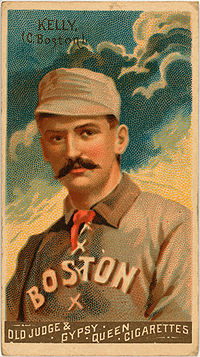
| Credit: Benjamin K. Edwards Collection |
Michael Joseph "King" Kelly (December 31, 1857 – November 8, 1894) was an American right fielder, catcher, and manager in various professional American baseball leagues including the National League, International Association, Players' League, and the American Association.
Associated Wikimedia
The following Wikimedia Foundation sister projects provide more on this subject:
-
Commons
Free media repository -
Wikibooks
Free textbooks and manuals -
Wikidata
Free knowledge base -
Wikinews
Free-content news -
Wikiquote
Collection of quotations -
Wikisource
Free-content library -
Wikiversity
Free learning tools -
Wiktionary
Dictionary and thesaurus
More portals
- Portals with triaged subpages from June 2018
- All portals with triaged subpages
- Portals with no named maintainer
- Automated article-slideshow portals with 51–100 articles in article list
- Automated article-slideshow portals with 501–1000 articles in article list
- Random portal component with 41–50 available subpages
- Automated article-slideshow portals with 201–500 articles in article list
- Random portal component with 11–15 available subpages
- Random portal component with 21–25 available image subpages

